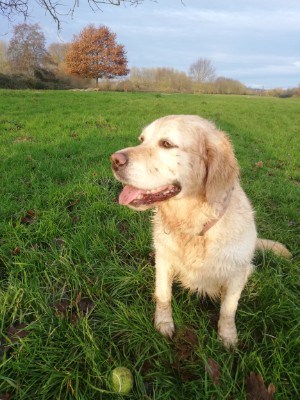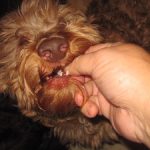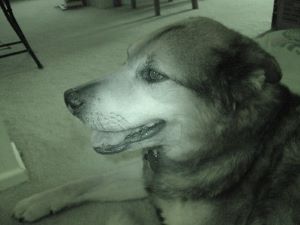
2020 has been a difficult year for most of us but one of the upsides is that people have exercised more.
Strava, the app that allows people to log their running, cycling or walking and share it with friends, noted that there was a 33% increase in activity levels.
The number of outdoor walks that were logged increased by three times.
And 55% of runners who have used Strava since 2019 logged a faster time for their run.
Unfortunately there seems to be no reliable statistic that shows how many dog owners run with their dogs.
All we know is that it is a very popular activity which brings huge benefits to both the dog and owner.
But a concern that some of us have is that when we have finished how long should our dog pant after exercise?
Which is the question that I want to want to answer in today’s post.
And to start off, I want to look at dog panting.
What you will learn from this article:
- Why do dogs pant?
- How long should a dog pant after exercise? Six factors
- How often do dogs breathe?
- What is my dog’s resting breath and heart rate?
- How to stop dog panting sooner: five tips
Why do dogs pant?
Dogs pant as a way of controlling their body’s temperature- to cool down when they get too hot.
One of the main ways that people control their body temperature is by sweating but dogs can’t do this because their coats insulate their body in hot and cold weather.
It is a bit more complicated than saying that dogs can’t sweat because they do- although most people are convinced that they don’t.
Dogs can sweat via their foot pads and in their ear canals, but panting is the main way that they do it.
How long should a dog pant after exercise? Six factors
It is very difficult, if not impossible to tell you exactly how long a dog will pant after exercise.
What I can do is to give you a list of factors which will affect how long your dog is panting.
And my list contains six elements.
- Age of dog
- Breed of dog
- Weight of dogs
- Outside temperature
- Fitness level of dog
- Intensity/ duration of exercise
Now, some of these are more obvious than others.
[1] Age of dog
Old or senior dogs will pant more and for longer than middle aged dogs.
And puppies will also be panting more than middle aged dogs.
I will discuss how younger and older dogs are more vulnerable in more detail later.
[2] Breed of dog
Some dogs are working breeds, other dogs are companion breeds.
It is stating the obvious to say that depending on the breed of your dog will determine how much exercise they need.
And some dogs are more prone to heavy panting or breathing difficulties.
And dog breeds that are particularly vulnerable are brachycephalic (or short nosed) dogs, such as the French Bulldog.
[3] Weight of dog
Dogs that are overweight or obese will pant more than dogs who are an ideal weight.
[4] Outside temperature
Although there are exceptions, most dogs do not do well when the temperature starts to get warmer.
They tend to try and find the coolest spot and stay there preserving as much of their energy as they can.
As a dog owner, it is really important to recognise this and not to exercise our dogs too vigorously on hot days.
My thirteen year old Golden Retriever would only walk for a few minutes this summer and I was really concerned and thinking the worst- that she was on her last legs.
Fast forward six months to the start of winter and she is walking for about an hour a day.
And the pace is “glacial” but the point I’m making is that she can walk these distances because the cooler temperatures are much easier to bear.
[5] Fitness level of dog
Dogs are like people and they need to (slowly) build their fitness levels.
Just because they are a dog doesn’t mean that they can participate in some hard exercise and then not feel any ill effects.
If your dog isn’t used to a certain level of intensity in their exercise, they will be panting far harder after it than if they had just stuck to their normal level.
[6] Level of exercise
This is very similar to the point made above, the more intensive or the longer that a dog exercises for, the longer that they will be panting.
But, when all is said and done, what you are looking for is a dog whose panting decreases quickly over a few minutes.
How often do dogs breathe?
According to vetStreet- a dog will take anything between fifteen to thirty breaths a minute.
Large breed dogs will take fewer breaths per minute and small dogs will take more.
The average is somewhere in the “mid twenties.”
Any breathing rate over thirty five breaths per minute should be considered unusual.
After vigorous exercise, a dog’s breathing rate can be ten times that (around 300 breathes per minute.)
To compare this with humans- at rest we should be taking 12- 20 breaths per minute whilst after exercise it can increase to about 40- 60 times per minute.
What is my dog’s resting breath and heart rate?
This is an easy and fun activity to do at home- you could even get the kids involved!
This video is a short watch, just over a minute and a half and it takes you step by step through the process.
Now most people who want to measure their dog’s breathing rate are doing it because they are worried about heart disease.
But if you want to check breathing rate to compare how it is after a bit of exercise then go for it.
How to stop dog panting sooner: five tips
[1] Your dog doesn’t know when to stop
If your dog gets too hot when exercising, they won’t know when to stop and slow down.
They will keep going and going because they want to please you.
They will only stop when it is too late and they are suffering from heatstroke.
You need to control the situation and make a decision before it is too late.
[2] On hotter days, exercise less
As a dog owner, there is very little that you can do to make intense exercise safer on the hottest days.
Short of exercising your dog before sunrise or after sun set or taking them to a beach or river to swim, you need to reduce the intensity and the duration of your dog’s walk.
[3] Stop for water
Another way to stop your dog from overheating is to have mini breaks- periods within the block of exercise where your dog stops, goes much slower or has a drink of water.
[4] Off lead time (during a run)
This builds on the point that I made above.
If it is safe to do so, try and give your dog some time off the lead.
This is particularly important if you are on a run with your dog.
Letting them off the lead gives them a chance to go at their own pace for a time- they will have a chance to go to potty, sniff around and generally go slower!
[5] Cool down
Nearly all of us will remember being told about the importance of a warm up before any form of exercise.
It was normally the job of your PE teacher to “bore you” repeatedly with this information before a lesson.
Well in recent years, we have come to understand the importance of cooling down after exercise.
That we shouldn’t just stop suddenly and that the last few minutes of any exercise should see a gentle decrease in intensity.
This helps our heart beat and our blood pressure to slowly return to normal.
The same is true for our dogs. Take the last few minutes of any exercise to slow and cool down.
This will help reduce their heart rate and slow their panting down and it will have the added benefit of making them calmer when they get home and be less frenzied as they drink from their water bowl.
[6] The right amount of water
I have already mentioned water as a means of helping your dog to cool and calm down and pant less.
It is important though that your dog doesn’t drink too much water too rapidly.
There is a potentially fatal condition called water toxicity or hyponatremia that a dog that ingests too much too rapidly can suffer from.
Granted the cases of this are very rare but dogs that love to drink straight from a hose are at risk.





